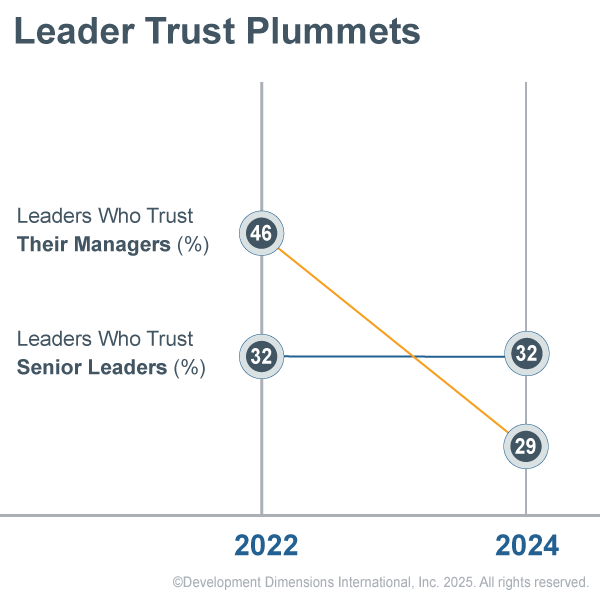I’ve served as a leader for over 12 years, and I’ve been a mid-level leader for half of them. During this time, I’ve had several realizations. Perhaps most glaring is that expectations of leaders are constantly evolving. The expectations of a frontline leader today are so much higher and harder than they were when I first moved into people leadership. And when leaders take on more responsibility, they have less time to spend on development. But as leaders get busier, leadership development arguably becomes even more crucial. Leaders often struggle to find time to learn new skills or reinforce old ones—which can negatively impact their teams and other areas of accountability. And this brings me to my next realization: if the roles of leaders are changing, approaches to development need to change alongside them. It’s time to reimagine the future of leadership development.
But the question is, how?
What Does Leadership Development Look Like Today?
I once coached a frontline leader who worked at an organization that offered leadership development for new leaders. The training consisted of three days of virtual classroom instruction on essential skills like coaching. The condensed time frame allowed new leaders to focus on development without it bleeding into their freshly minted schedules. And it seemed to work.
However, nine months into their role, this leader encountered their first coaching conversation with a direct report—only to realize they were at a loss. The leader had all but forgotten their training from months prior. Worse, they couldn’t refer to a content library for a refresher on coaching. They weren’t even able to practice and gain feedback before the coaching session without enlisting the help of their own manager. So, they were left scrambling to find their training materials sent to them nearly a year ago.
That, in a nutshell, is the reality of leadership development in many organizations today. And for some of them, concentrated development experiences on a yearly basis work well. But for the frontline leader mentioned, ongoing learning experiences would have served them better in their time of need.
What Makes Leadership Development Challenging?
Frankly, leaders are not going to be able to magically carve out more time for leadership development compared to previous years. In fact, only 30% of leaders globally feel they have enough time to do their job well. It pains me to say that making time for development will only get harder as new priorities and challenges compete for your leaders’ attention. And this problem is made worse as organizations continue to flatten—a trend I anticipate won’t make its exit anytime soon. This means leaders at all levels will have heavier workloads and busier schedules than ever before. They will be asked not only to do more but to be more. And they may not know where to even begin.
For instance, frontline leaders have historically assumed the roles of supervisors, taking on the bulk of managerial tasks you’d expect—delegation, coaching, resolving conflict, etc. Now, these leaders are being asked to take on more entrepreneurial roles. To come up with more innovative solutions to complex organizational problems. To use business acumen skills that they simply may not have.
On top of this, the world of work is constantly evolving. For leaders to keep up with change, their training should be continuously refreshed for relevancy. That is, relevant to each leader’s role, level, goals, and unique context. Unfortunately, many companies have formed a habit of creating “one-size-fits-all” development programs that are only refreshed once every half-decade. Could you imagine using a leadership program older than your smartphone?
That, in a nutshell, is the reality of leadership development in many organizations today. And for some of them, concentrated development experiences on a yearly basis work well. But for the frontline leader mentioned, ongoing learning experiences would have served them better in their moment of need.
But you can’t blame learning and development professionals. Creating deeply personalized development experiences for every leader across levels is no easy feat. Not only do many programs end up lacking skill reinforcement, but they also fall short of the personalization needed to create meaningful behavior change and growth.
Insights on the Future of Leadership Development
Trust in leadership is in crisis. According to DDI’s Global Leadership Forecast 2025, trust in managers plummeted from 46% to 29% between 2022 and 2024. This 17-point decline signals growing skepticism toward leadership. With this drop in confidence, there is an urgent need to reassess how we prepare leaders for future challenges.

Fewer leaders are getting the training they need today to meet future challenges. In our research we also identified critical gaps in these future-focused leadership skills:
- Setting Strategy
- Managing Change
- Identifying and Developing Future Talent
- Decision Making and Prioritization
These skills aren't just important for business performance—they're essential for rebuilding trust. When leaders demonstrate forward-thinking capabilities, they inspire confidence in their teams. Yet these skills are particularly challenging because they require leaders to think beyond immediate pressures and anticipate what's next.
The urgency for addressing these skill gaps is clear: 83% of HR organizations predict a need for new leadership capabilities within the next five years. But with a growing leadership credibility crisis at stake, organizations can’t afford to wait.
Fortunately, there are several trust-building behaviors that leaders can practice to bridge the trust gap, such as displaying vulnerability and acknowledging failures. But these skills must be developed first to drive impact. By investing in leadership development now—especially in these critical areas—organizations can reverse the trust decline and prepare for the challenges ahead.
How Do Leaders Prefer to Learn?
Leaders find it deeply valuable to engage with bespoke learning content that resonates with their development needs. And if the content checks out for relevance, you’ll capture their attention. Otherwise, you might as well provide them with links to several inspirational leadership videos and hope for the best. So, what does bespoke learning content look like? It’s a more scalable solution than you might expect. It’s about providing content that is designed for their level of leadership, with case studies and examples that match the context of leadership that they face, and assessments that help the leader personalize where they will get the best return on development efforts—their unique strengths and improvement areas.
Many organizations also assume that their busy leaders look to online, self-guided study as a blessing in disguise. The idea of leaders being able to absorb learning materials during their downtime and not in between meetings is certainly tempting. But according to the Global Leadership Forecast 2025, the most effective development doesn’t rely on a single format.
Beyond the format itself, leaders are having tremendous breakthroughs in their own skill development when they learn alongside peers who go through similar challenges. Group learning cuts through the loneliness typically associated with leadership, allowing leaders to form communities around shared issues while practicing skills to solve them together. This is critical for L&D leaders and practitioners to know, because we have seen the development pendulum swing hard towards online self-study. When you allow each leader to browse through and choose different content to learn on their own, you forgo the opportunity to build one unified leadership culture. And when your culture is fractured, and self-study usage is down, you are left wondering whether your development investments truly paid off.
Shaping the Future of Leadership Development
As we look to the future of leadership development, we should consider several factors. First and foremost, content is only as good as its context and vice versa. Leadership development should provide the content leaders need to target their key development areas while also fitting into the context they’re in. Leaders are busy, and their time will always be limited. The key to developing them is giving them training they actually want to invest the time to complete in the modalities they are asking for. And you don’t have to prioritize one learning preference over the other! Blended learning strategies give you a mix of the classroom engagement that leaders want while blending in flexible online learning materials to reinforce skills and give real-time support.
Keep in mind that buyers aren’t the only ones looking to see a return on their leadership development investment. Leaders themselves want to know whether they’re getting better. And it’s not enough to simply tell them they are. Leaders want to see the results of skill training pay off in their everyday conversations and how they execute strategy. They want personalized self-assessment insights to show them areas of improvement and key actions they can take to improve behaviors.
Not sure where to begin? Start by thinking of developing leaders as simply meeting them where they are. Provide them with support day by day, come what may. Because leadership is hard. Making time for leadership development is even harder. So, if we can’t make time for leadership development at work, let’s make it a way of work instead.
About the Author
Verity Creedy is Vice President of DDI’s Product Management team and an award-winning blogger. Verity is obsessed with building powerful development experiences for leaders, trying to hold a decent plank for two minutes, and keeping indoor plants alive for more than six months.
Have a Question?
FAQ
-
What are the key trends shaping the future of leadership development?
DDI’s leadership experts highlight key trends such as the growing need for adaptability, emotional intelligence, digital fluency, and inclusive leadership. As the business environment evolves rapidly, organizations must focus on developing these critical future-ready skills to stay competitive.
-
How is leadership development changing in the digital era?
According to DDI’s research, leadership development is moving toward more virtual experiences, real-time skill practice, AI-driven coaching, and highly personalized development paths. DDI’s leadership solutions integrate these innovations to create scalable, impactful learning journeys for organizations.
-
Why is emotional intelligence critical for future leaders?
DDI emphasizes that emotional intelligence is becoming a core leadership competency. Leaders with strong emotional intelligence can build trust, foster resilience, manage change effectively, and create inclusive environments — all essential for leading in an uncertain future.
-
How can DDI help organizations prepare their leaders for the future?
DDI helps organizations prepare for the future by delivering leadership development programs that emphasize agility, emotional intelligence, strategic foresight, and digital skills. DDI’s innovative virtual learning and coaching solutions ensure leaders are equipped to thrive in dynamic environments.
Topics covered in this blog

